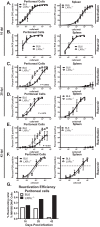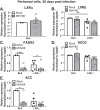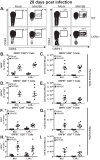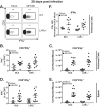LXR Alpha Restricts Gammaherpesvirus Reactivation from Latently Infected Peritoneal Cells
- PMID: 30602604
- PMCID: PMC6401431
- DOI: 10.1128/JVI.02071-18
LXR Alpha Restricts Gammaherpesvirus Reactivation from Latently Infected Peritoneal Cells
Abstract
Gammaherpesviruses are ubiquitous viruses that establish lifelong infections. Importantly, these viruses are associated with numerous cancers and lymphoproliferative diseases. While risk factors for developing gammaherpesvirus-driven cancers are poorly understood, it is clear that elevated viral reactivation from latency often precedes oncogenesis. Here, we demonstrate that the liver X receptor alpha isoform (LXRα) restricts gammaherpesvirus reactivation in an anatomic-site-specific manner. We have previously demonstrated that deficiency of both LXR isoforms (α and β) leads to an increase in fatty acid and cholesterol synthesis in primary macrophage cultures, with a corresponding increase in gammaherpesvirus replication. Interestingly, expression of fatty acid synthesis genes was not derepressed in LXRα-deficient hosts, indicating that the antiviral effects of LXRα are independent of lipogenesis. Additionally, the critical host defenses against gammaherpesvirus reactivation, virus-specific CD8+ T cells and interferon (IFN) signaling, remained intact in the absence of LXRα. Remarkably, using a murine gammaherpesvirus 68 (MHV68) reporter virus, we discovered that LXRα expression dictates the cellular tropism of MHV68 in the peritoneal cavity. Specifically, LXRα-/- mice exhibit reduced latency within the peritoneal B cell compartment and elevated latency within F4/80+ cells. Thus, LXRα restricts gammaherpesvirus reactivation through a novel mechanism that is independent of the known CD8+ T cell-based antiviral responses or changes in lipid synthesis and likely involves changes in the tropism of MHV68 in the peritoneal cavity.IMPORTANCE Liver X receptors (LXRs) are nuclear receptors that mediate cholesterol and fatty acid homeostasis. Importantly, as ligand-activated transcription factors, LXRs represent potential targets for the treatment of hypercholesterolemia and atherosclerosis. Here, we demonstrate that LXRα, one of the two LXR isoforms, restricts reactivation of latent gammaherpesvirus from peritoneal cells. As gammaherpesviruses are ubiquitous oncogenic agents, LXRs may represent a targetable host factor for the treatment of poorly controlled gammaherpesvirus infection and associated lymphomagenesis.
Keywords: chronic infection; gammaherpesvirus; liver X receptor alpha; peritoneal B cells.
Copyright © 2019 American Society for Microbiology.
Figures






Similar articles
-
Interferon Regulatory Factor 7 Attenuates Chronic Gammaherpesvirus Infection.J Virol. 2020 Nov 23;94(24):e01554-20. doi: 10.1128/JVI.01554-20. Print 2020 Nov 23. J Virol. 2020. PMID: 32967960 Free PMC article.
-
Conserved Gammaherpesvirus Protein Kinase Counters the Antiviral Effects of Myeloid Cell-Specific STAT1 Expression To Promote the Establishment of Splenic B Cell Latency.J Virol. 2021 Aug 10;95(17):e0085921. doi: 10.1128/JVI.00859-21. Epub 2021 Aug 10. J Virol. 2021. PMID: 34132573 Free PMC article.
-
B Cell-Specific Expression of Ataxia-Telangiectasia Mutated Protein Kinase Promotes Chronic Gammaherpesvirus Infection.J Virol. 2017 Sep 12;91(19):e01103-17. doi: 10.1128/JVI.01103-17. Print 2017 Oct 1. J Virol. 2017. PMID: 28701397 Free PMC article.
-
Gamma interferon blocks gammaherpesvirus reactivation from latency in a cell type-specific manner.J Virol. 2007 Jun;81(11):6134-40. doi: 10.1128/JVI.00108-07. Epub 2007 Mar 14. J Virol. 2007. PMID: 17360749 Free PMC article. Review.
-
Pathogenesis and host control of gammaherpesviruses: lessons from the mouse.Annu Rev Immunol. 2011;29:351-97. doi: 10.1146/annurev-immunol-072710-081639. Annu Rev Immunol. 2011. PMID: 21219186 Review.
Cited by
-
Conquering the Host: Determinants of Pathogenesis Learned from Murine Gammaherpesvirus 68.Annu Rev Virol. 2021 Sep 29;8(1):349-371. doi: 10.1146/annurev-virology-011921-082615. Annu Rev Virol. 2021. PMID: 34586873 Free PMC article.
-
Low-Density Lipoprotein Receptor Suppresses the Endogenous Cholesterol Synthesis Pathway To Oppose Gammaherpesvirus Replication in Primary Macrophages.J Virol. 2021 Aug 10;95(17):e0064921. doi: 10.1128/JVI.00649-21. Epub 2021 Aug 10. J Virol. 2021. PMID: 34105999 Free PMC article.
-
Optimized Detection of Acute MHV68 Infection With a Reporter System Identifies Large Peritoneal Macrophages as a Dominant Target of Primary Infection.Front Microbiol. 2021 Mar 9;12:656979. doi: 10.3389/fmicb.2021.656979. eCollection 2021. Front Microbiol. 2021. PMID: 33767688 Free PMC article.
-
Endosomal Cholesterol in Viral Infections - A Common Denominator?Front Physiol. 2021 Nov 11;12:750544. doi: 10.3389/fphys.2021.750544. eCollection 2021. Front Physiol. 2021. PMID: 34858206 Free PMC article. Review.
-
Liver X Receptor-Inducible Host E3 Ligase IDOL Targets a Human Cytomegalovirus Reactivation Determinant.J Virol. 2023 Jul 27;97(7):e0075823. doi: 10.1128/jvi.00758-23. Epub 2023 Jun 20. J Virol. 2023. PMID: 37338407 Free PMC article.
References
-
- Campbell TB, Borok M, Gwanzura L, MaWhinney S, White IE, Ndemera B, Gudza I, Fitzpatrick L, Schooley RT. 2000. Relationship of human herpesvirus 8 peripheral blood virus load and Kaposi's sarcoma clinical stage. AIDS 14:2109–2116. - PubMed
-
- Feng WH, Cohen JI, Fischer S, Li L, Sneller M, Goldbach-Mansky R, Raab-Traub N, Delecluse HJ, Kenney SC. 2004. Reactivation of latent Epstein-Barr virus by methotrexate: a potential contributor to methotrexate-associated lymphomas. J Natl Cancer Inst 96:1691–1702. doi:10.1093/jnci/djh313. - DOI - PubMed
-
- Orlandi E, Paulli M, Viglio A, Pagnucco G, Riboni R, Baldanti F, Lazzarino M. 2001. Epstein-Barr virus-positive aggressive lymphoma as a consequence of immunosuppression after multiple salvage treatments for follicular lymphoma. Br J Haematol 112:373–376. - PubMed
Publication types
MeSH terms
Substances
Grants and funding
LinkOut - more resources
Full Text Sources
Research Materials

